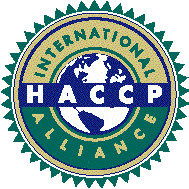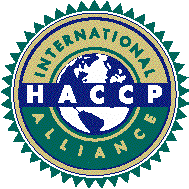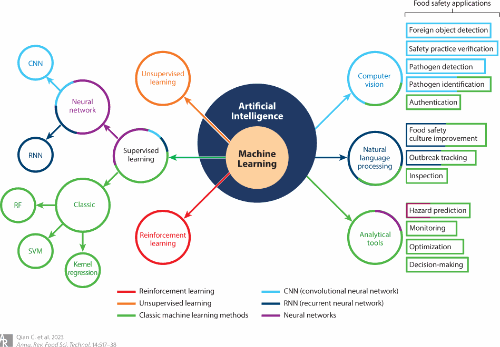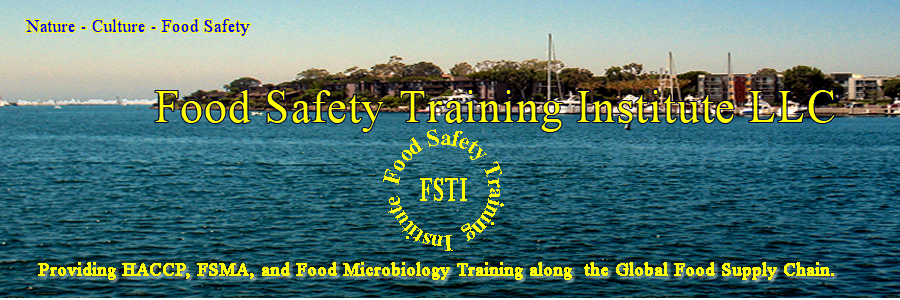Welcome to the Food Safety Training Institute and the Applications of Artificial Intelligence (AI) to Food Safety HACCP Course. The National Advisory Committee on Microbiological Criteria for Foods (NACMCF) who wrote the seven principles of HACCP defined a step as a point, procedure, operation or stage in the food system from primary production to final consumption. The FDA Food Safety Modernization Act (FSMA) requires the use of current scientific and technical understanding to manufacture, process, pack and hold foods. This course is designed to develop HACCP and Food Safety Plans using all components of artificial intelligence such as machine learning, deep learning, computer vision, natural language processing, analytics and other related tools and techniques to assure the safety of the food from farm to table. In addition, the course will discuss the use of combining Artificial Intelligence (AI) with sensor technologies such as biosensors, chemo-sensors, E-noise, E-tong and robotics, drones, big data, omics, blockchain, cloud computing and other current technologies along the national and global food supply chain to make sure the food and ingredients are produced, processed, packed, held, transported and distributed using current regulatory, scientific, and technical understanding. Furthermore, for putting all these sciences and technologies in the hands of all involved in food production, processing, packing, holding, transporting, distributing, and retailing, an in-depth analysis and sources will be presented in the use of smartphones as microscopes, chemo-sensors and bio-sensors. Upon completion of the course, you will receive a certificate with the seal of the International HACCP Alliance.



On Zoom – Instructor-Led
Table of Contents
Module 1 Introduction, History of Food Safety Hazards and Controls and Artificial Intelligence
Module 2. The FDA New Era of Smarter Food Safety and Use of Artificial Intelligence for Food Safety
Module 3. The USDA Applications of Artificial Intelligence throughout Agriculture and the Food Supply Chain
Module 4. How Can Artificial Intelligence Help Improve Food Safety (in production, processing, storage, distribution, pathogen identification and evaluation)
Module 5 Rapid Bacteria Detection Method Using Artificial Intelligence
Module 6. Artificial Intelligence Opportunities to Improve Food Safety at Retail
Module 7. Artificial intelligence, big data, and blockchain in food safety
Module 8. Hyperspectral imaging and machine learning in food microbiology Developments and challenges in detection of bacterial, fungal and viral contaminants
Module 9. Hyperspectral imaging of common foodborne pathogens for rapid identification and differentiation
Module 10. Artificial Intelligence technology in food safety – A behavioral approach
Module 11. Artificial intelligence and real-world data for drug and food safety – A regulatory science perspective
Module 12. Rapid identification of foodborne bacteria with hyperspectral microscopic imaging and artificial intelligence
classification algorithms
Module 13. The review of food safety inspection systems based on artificial intelligence, image processing, and robotics
Module 14. Smartphone-Based Food Diagnostic Technologies – A Review
Module 15. ChatGPT (Chat Generative Pre-Learned Transformer) and Food Safety
Module 16. Application of Artificial Intelligence in Food Industry—a Guideline
Module 17. Deep Learning and Machine Vision for Food Processing – A Survey
Module 18. Biological Hazards and Controls
Module 19. Chemical Food Safety Hazards and Hurdle and Emerging Technologies
Module 20. HACCP and Prerequisite Programs
Module 21. Preliminary Steps
Module 22. The First Principle of HACCP: Conduct a Hazard Analysis
Module 23. The Second Principle of HACCP – Determine Critical Control Points (CCPs)
Module 24. The Third Principle of HACCP – Determine Critical Limits
Module 25. The Fourth Principle of HACCP – Establish Monitoring Procedures
Module 26. The Fifth Principle of HACCP – Establish Corrective Actions Procedures
Module 27. The Sixth Principle of HACCP – Establish Verification Procedures
Module 28. The Seventh Principle: of HACCP – Establish Record-Keeping and Documentation Procedures
Module 29. Development, Implementation, Maintenance and Reassessment of HACCP Plans and HACCP Systems
2024
August 9, 2024 – 8:00 AM to 4:00 PM – PST
August 10, 2024 – 8:00 AM to 4:00 PM – PST
October 11, 2024 – 8:00 AM to 4:00 PM – EST
October 12, 2024 – 8:00 AM to 4:00 PM – EST
December 13, 2024 – 8:00 AM to 4:00 PM – PST
December 14, 2024 – 8:00 AM to 4:00 PM – PST
2025 Classes
March 13, 14, 2025 – EST
April 1, 2, 2025 – PST
June 2, 3, 2025 – EST
July 17, 18, 2025 – PST
August 25, 26, 2025 – EST
Self-Paced to be completed
in 60 Days
Table of Contents
Module 1 Introduction, History of Food Safety Hazards and Controls and Artificial Intelligence
Module 2. The FDA New Era of Smarter Food Safety and Use of Artificial Intelligence for Food Safety
Module 3. The USDA Applications of Artificial Intelligence throughout Agriculture and the Food Supply Chain
Module 4. How Can Artificial Intelligence Help Improve Food Safety (in production, processing, storage, distribution, pathogen identification and evaluation)
Module 5 Rapid Bacteria Detection Method Using Artificial Intelligence
Module 6. Artificial Intelligence Opportunities to Improve Food Safety at Retail
Module 7. Artificial intelligence, big data, and blockchain in food safety
Module 8. Hyperspectral imaging and machine learning in food microbiology Developments and challenges in detection of bacterial, fungal and viral contaminants
Module 9. Hyperspectral imaging of common foodborne pathogens for rapid identification and differentiation
Module 10. Artificial Intelligence technology in food safety – A behavioral approach
Module 11. Artificial intelligence and real-world data for drug and food safety – A regulatory science perspective
Module 12. Rapid identification of foodborne bacteria with hyperspectral microscopic imaging and artificial intelligence
classification algorithms
Module 13. The review of food safety inspection systems based on artificial intelligence, image processing, and robotics
Module 14. Smartphone-Based Food Diagnostic Technologies – A Review
Module 15. ChatGPT (Chat Generative Pre-Learned Transformer) and Food Safety
Module 16. Application of Artificial Intelligence in Food Industry—a Guideline
Module 17. Deep Learning and Machine Vision for Food Processing – A Survey
Module 18. Biological Hazards and Controls
Module 19. Chemical Food Safety Hazards and Hurdle and Emerging Technologies
Module 20. HACCP and Prerequisite Programs
Module 21. Preliminary Steps
Module 22. The First Principle of HACCP: Conduct a Hazard Analysis
Module 23. The Second Principle of HACCP – Determine Critical Control Points (CCPs)
Module 24. The Third Principle of HACCP – Determine Critical Limits
Module 25. The Fourth Principle of HACCP – Establish Monitoring Procedures
Module 26. The Fifth Principle of HACCP – Establish Corrective Actions Procedures
Module 27. The Sixth Principle of HACCP – Establish Verification Procedures
Module 28. The Seventh Principle: of HACCP – Establish Record-Keeping and Documentation Procedures
Module 29. Development, Implementation, Maintenance and Reassessment of HACCP Plans and HACCP Systems
Onsite Training
in Hermosa Beach California
or Your Site
Table of Contents
Module 1 Introduction, History of Food Safety Hazards and Controls and Artificial Intelligence
Module 2. The FDA New Era of Smarter Food Safety and Use of Artificial Intelligence for Food Safety
Module 3. The USDA Applications of Artificial Intelligence throughout Agriculture and the Food Supply Chain
Module 4. How Can Artificial Intelligence Help Improve Food Safety (in production, processing, storage, distribution, pathogen identification and evaluation)
Module 5 Rapid Bacteria Detection Method Using Artificial Intelligence
Module 6. Artificial Intelligence Opportunities to Improve Food Safety at Retail
Module 7. Artificial intelligence, big data, and blockchain in food safety
Module 8. Hyperspectral imaging and machine learning in food microbiology Developments and challenges in detection of bacterial, fungal and viral contaminants
Module 9. Hyperspectral imaging of common foodborne pathogens for rapid identification and differentiation
Module 10. Artificial Intelligence technology in food safety – A behavioral approach
Module 11. Artificial intelligence and real-world data for drug and food safety – A regulatory science perspective
Module 12. Rapid identification of foodborne bacteria with hyperspectral microscopic imaging and artificial intelligence
classification algorithms
Module 13. The review of food safety inspection systems based on artificial intelligence, image processing, and robotics
Module 14. Smartphone-Based Food Diagnostic Technologies – A Review
Module 15. ChatGPT (Chat Generative Pre-Learned Transformer) and Food Safety
Module 16. Application of Artificial Intelligence in Food Industry—a Guideline
Module 17. Deep Learning and Machine Vision for Food Processing – A Survey
Module 18. Biological Hazards and Controls
Module 19. Chemical Food Safety Hazards and Hurdle and Emerging Technologies
Module 20. HACCP and Prerequisite Programs
Module 21. Preliminary Steps
Module 22. The First Principle of HACCP: Conduct a Hazard Analysis
Module 23. The Second Principle of HACCP – Determine Critical Control Points (CCPs)
Module 24. The Third Principle of HACCP – Determine Critical Limits
Module 25. The Fourth Principle of HACCP – Establish Monitoring Procedures
Module 26. The Fifth Principle of HACCP – Establish Corrective Actions Procedures
Module 27. The Sixth Principle of HACCP – Establish Verification Procedures
Module 28. The Seventh Principle: of HACCP – Establish Record-Keeping and Documentation Procedures
Module 29. Development, Implementation, Maintenance and Reassessment of HACCP Plans and HACCP Systems


